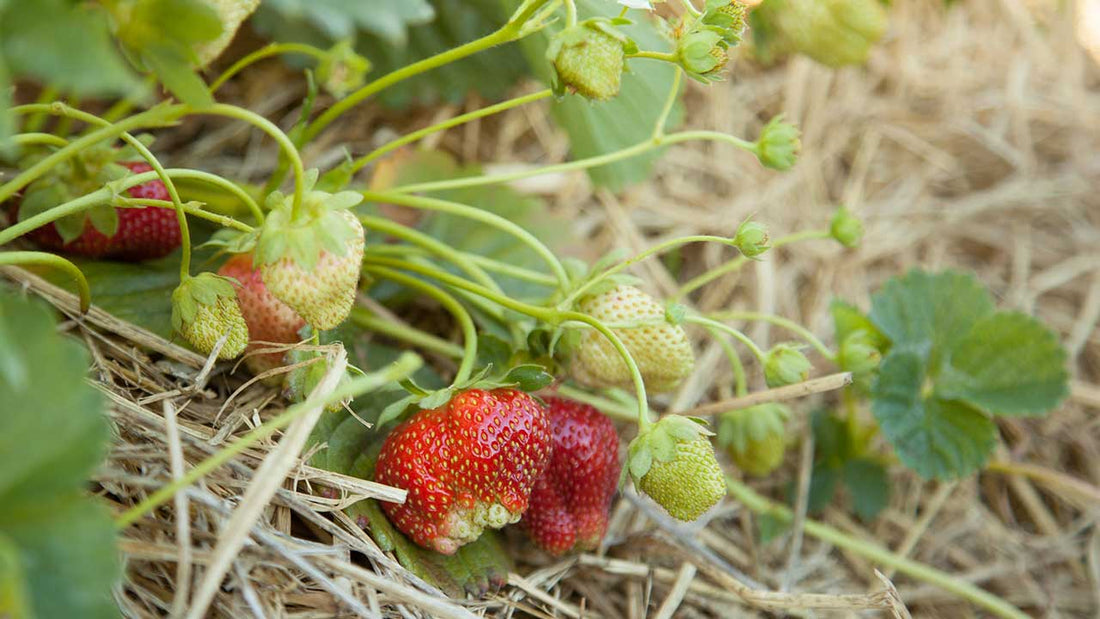A Guide to Peaceful Valley's Bare Root Strawberry Plants
Depending on the type of strawberry, these delicious fruits can be harvested anywhere from late spring to mid-fall. Strawberries vary in size, shape, color, and taste depending on the variety. Most varieties range from one to two inches in diameter and are bright red with a small green stem still attached. The taste of strawberries is strongly affected by weather conditions such as sunshine and rainfall during the ripening period.
We offer approximately 15 varieties of strawberries for sale, from bundles of 25 through 1,500 plants. Here are details on our most popular varieties.
June Bearers - Prolific Producers in Warmer, Southern Regions
Generally produce a single large crop in spring to early summer, as early as March in warmer regions such as Southern California and Florida. These June bearer strawberries are prolific producers for 3 to 4 weeks. They are a good choice for growers who want to limit their growing season for marketing or home processing reasons.
Since June Bearers spread their runners very rapidly, many growers consider the “matted row method” to be the most effective means of propagation. Rows are spaced 3-4’ apart with berry plants spaced at 18-24” apart. Plants are then allowed to “runner” freely in all directions, creating larger rows centered on the original mother plants. All flowers should be removed the first year of growth to allow for maximum runner spread.
Fruit production will occur the second year from the runners. A post-harvest regime of mowing plants down to 2” and tilling to within 10” of the original row will extend bed life for up to 3 years. Tilling up the original row, and leaving second or third generation plants to form new rows can extend bed life even longer.
Produces lots of semi-early fruit. The fruit size is medium to large, and medium in firmness. Very nice, sweet, dessert-quality flavor. Immensely popular in California, especially for southern California winter production; also performs well in the east and worth trying in the south.
Fronteras
Highly productive and has large, conical fruit. Moderately or highly resistant to Verticillium, Fusarium, and Phytophthora. Preliminary trials indicate that Fronteras has substantial resistance to Macrophomina. It has good resistance to powdery mildew and seems tolerant of spider mites.
Sequoia
One of the best tasting berries ever. Produces lots of huge, dark red, sweet fruit. Where safe from early frost it is the earliest Spring crop and keeps bearing fruit weeks longer than the typical Spring crop. Works best in California and southern states.
Honeoye
Popular, versatile start that works well in the north. Heavy yields of very large, sweet fruit, and excellent winter tolerance. Honeoye is great for both the backyard and U-Pick operations.
Eclair
Early season productivity of medium-large, wedge-shaped, extremely sweet and fragrant berries, with medium-firm flesh. With parent stock consisting of both springbearing and everbearing varieties, it will produce longer into the season than Sequoia and other springbearing varieties. Resistant to, or tolerant of, garden soil diseases.
Allstar
Large, sweet, orange red fruit holds its size well and works for fresh eating or canning. Easy to grow, vigorous, and productive. Resistant to soil fungi, works well all over the USA. Large, sweet fruit for fresh eating or canning.
Everbearers - Popular in Northern Climates
The most productive in northern areas where summer brings extended daylight hours. These varieties are not as prolific as June Bearers but are especially suitable for growers who wish to harvest an intermittent supply of berries in the summer. Also, you will get fruit the first year after planting, unlike June Bearers.
Many growers prefer to use the “Hill System,” for Everbearers when considering strawberry plant spacing. Space plants 12-15” apart in double or triple wide rows with 1.5-2’ between rows. Remove the first set of flowers after planting, and pull up all runners throughout spring and summer to increase fruit production.
Keeping these varieties trimmed of old, decaying foliage will allow better air circulation across the bed and result in high berry quality. Allow runners to develop in the second season to establish a new generation of plants; production of the original mother plants will decrease after the second season. After the second year’s harvest, pull out the mother plants, leaving only new plants spaced on the original bedding plan.
A moderate day-neutral cultivar from California. A vigorous plant. Monterey has outstanding flavor with a distinct sweet aftertaste that is unique among California cultivars. Monterey has a good disease resistance profile, although it is susceptible to powdery mildew.
High-quality, very sweet berries, producing round-shaped fruit. Fruits in spring and has been known to fruit all summer. Grows and fruits well in hot dry climates. Produces fewer runners than spring bearing varieties. Broad resistance to fungal diseases.
High-quality, very sweet berries, producing large symmetrical fruit. Bears May to August Resistant to Verticillium wilt, Phytophthora crown rot and relatively resistant to Anthracnose crown rot.
Quinault
Quinault produces large, sweet fruit, good for desserts, preserves and eating fresh. Not suggested for freezing. Recommended for Alaska, the Pacific Northwest and the Midwest.
Ozark
One of America’s most popular everbearing varieties. Ozark produces sweet, full-flavored, wedge-shaped fruit, excellent for preserves or freezing. Very hardy, producing heavy yields from summer through fall.
Fort Laramie
Beautiful, large, red fruit with firm, aromatic flesh. Winter hardy -- works best in colder areas of the USA and Canada (not recommended for Alaska or the South.) Eat fresh, freeze, or make jam. Works well in hanging baskets.
Eversweet
Fruits throughout spring, summer, and fall, even when temperatures are over 90 degrees. Large berries with outstanding flavor. Recommended for freezing, but wonderful fresh from the harvest! Works well in hanging baskets. Eversweet shows very good results all over the USA.
For more information on growing BIG strawberries organically, see our guide.

